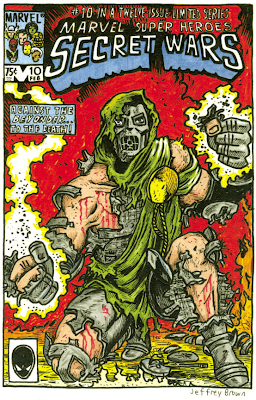 Teen Titans #20
Teen Titans #20 (On Sale: January 23, 1969) has a cover by
Nick Cardy.
"Titans Fit the Battle of Jericho" is written and penciled by
Neal Adams and inked by
Nick Cardy, but that description doesn't even come close to explaining the real pedigree of this tale.
Len Wein and
Marv Wolfman turned in a story to editor
Dick Giordano which would have introduced a black super-hero by the name of Jericho, but this story was never published. The character was changed to Caucasian and renamed as Joshua. Although the cover still bears the original title:
"The Titans Fit the Battle of Jericho."
In
The Titans Companion by
Glen Cadigan, Marv Wolfman reflects on the story: "The second
Teen Titans was a story that no one has ever seen printed. It was a story that
Len Wein and I co-wrote that was originally intended for
Teen Titans #20. It was '
The Titans Fit the Battle of Jericho'..."We met with
Dick Giordano, and told him our idea of a gang, a black super-hero, and a fairly straightforward type of story, closer to what we were seeing in
Spider-Man, but with the Teen Titans. We came up with a black character because DC didn't have any at the time...we grew up with black kids in school. Living in New York, all racers, all creeds, everybody was in our classes, so it was never a matter of 'Why not put a black character in?' it's "Why isn't there one?' I mean, like, 'Duh!' So we just wanted to do that.
"Dick liked the story concept, but knew that there could be some problems because of the time period, and brought us into
Irwin Donenfeld's...Irwin said he really wanted us to try to do this, try to make it a multi-parter -- which, in itself, was incredibly exciting -- to really be powerful and very street and very authentic, and try to get down and dirty, get a lit grittier...
"A couple of weeks later we came back, and at that point Irwin had left and there was a new person in charge. Whatever the reasons were, because there are so many differences of opinion on this, the story got dropped...It was all drawn, buy the way.
Nick Cardy did one of the greatest jobs I had ever seen him do.

"When it was killed, Dick was in a lot of trouble because of deadlines.
Neal Adams took a lot of the pages, added a bunch of new pages and rewrote a story around it; a brand-new story, using Jericho, but no longer black. If you look at the cover, which had already been sent to the printer, all they could do was throw a blue tone over it and all the black characters were put into the background because of that, but they were obviously black on the cover and there were none in the comic anymore...
"At any rate, Neal redrew the story using as many of
Nick Cardy's pages as he could. He did it, I think, over a weekend with Nick inking simultaneously. I plotted, secretly, the second chapter which Neal followed and made changes along the way, then he wound up the story on his own...Len and I didn't get work for almost two years from DC."
In Adams' tale, a mysterious costumed crime fighter called Joshua invades Titan Lair and enlists the Teen Titans' aid in stopping a confrontation between police and teenage protesters. All involved are unaware that the protesters are being backed by organized crime figures, who in turn are pawns of the alien invaders from Dimension X. The Titans, together with Joshua and his brother, the leader of the protesters, halt the aliens' scheme to release the Meroul Being, a monstrous giant creature, on Earth, but both the aliens and their criminal underlings continue to plot the team's downfall. Reprinted in
Best of DC #18 and
Showcase Presents: Teen Titans Vol. 2 TPB.
Edited by
Dick Giordano.













































